Key takeaways:
- Traditional car washing methods can waste 40 to 80 gallons of water, prompting a need for more efficient practices.
- Adopting water-saving techniques, such as using buckets and waterless car wash products, significantly reduces water consumption.
- Choosing the right tools, like high-pressure washers and foam cannons, can enhance cleaning efficiency while conserving water.
- Tracking water usage and being mindful of washing habits leads to noticeable improvements in both sustainability and vehicle cleanliness.
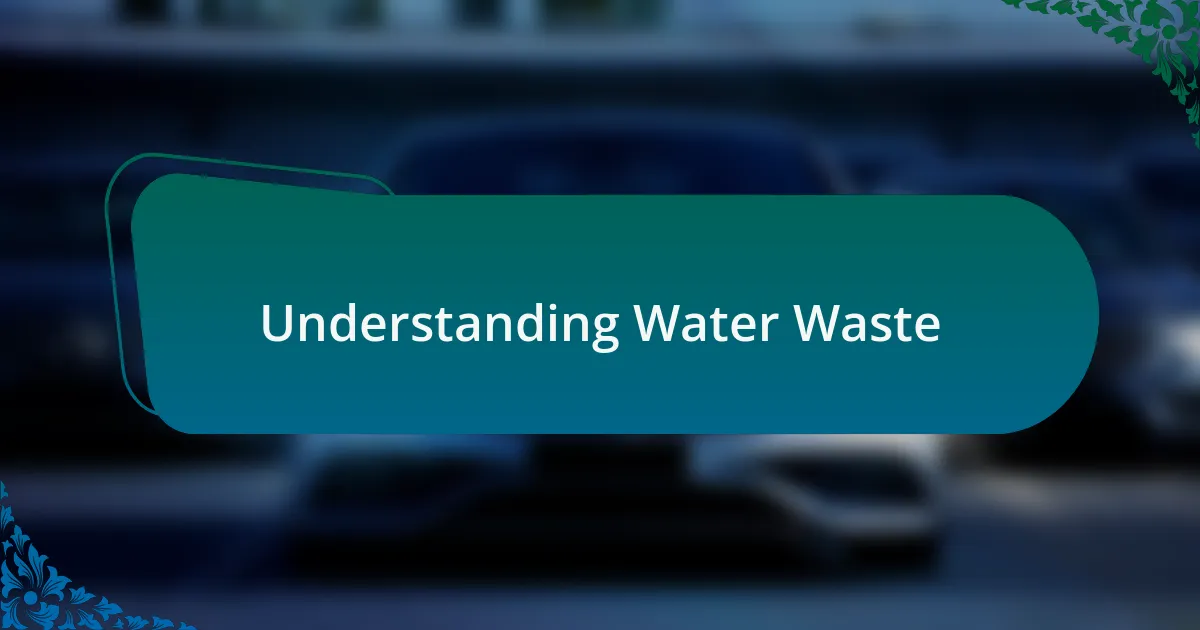
Understanding Water Waste
Water waste is often a silent companion in daily tasks, and washing is no exception. I remember the first time I realized just how much water could get wasted during a simple car wash. It struck me as alarming—do we really need to use so much water for something that can be done more efficiently?
When I began to pay attention, I discovered that traditional washing methods can consume anywhere from 40 to 80 gallons per wash. That’s staggering! Think about it: how many washes do you do in a month? Multiply that number, and you see the impact not just on your water bill but on the environment too. It made me question my habits and consider how my choices contribute to a larger issue.
Every drop counts, and it’s easy to overlook that when we’re busy. I once found myself in the middle of a long-winded wash, only to realize I was rinsing off with the water still running. It was an eye-opener. I started to reflect: how often do we let water flow without thinking? Recognizing these moments has pushed me to be more mindful and embrace techniques that save this precious resource.
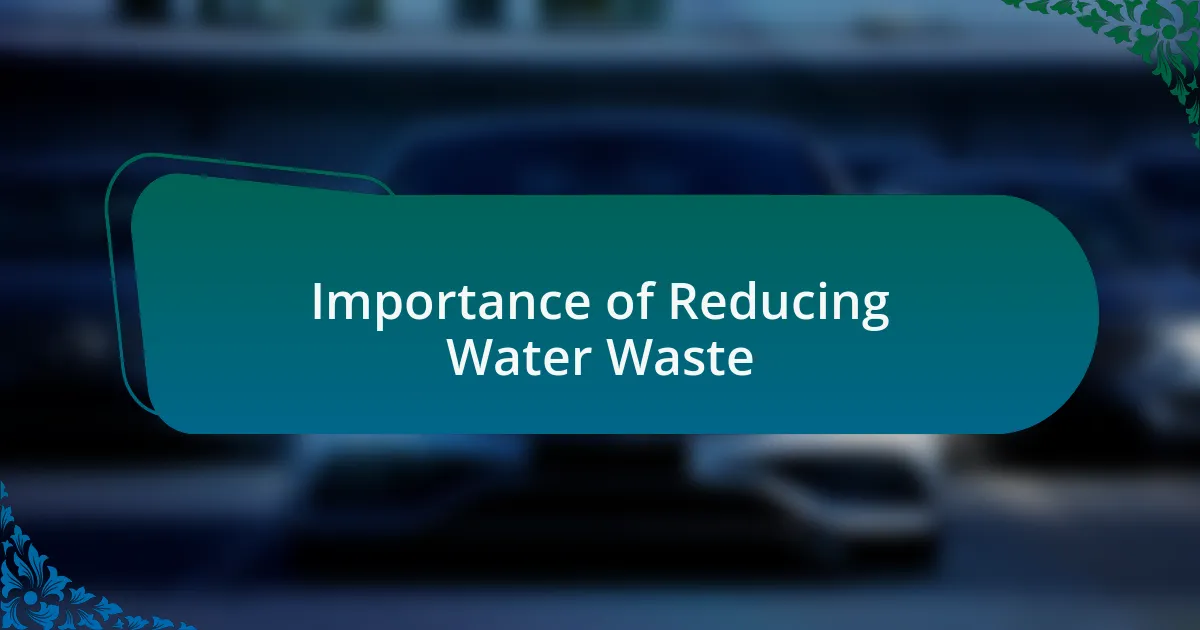
Importance of Reducing Water Waste
Reducing water waste is crucial not only for our wallets but also for our planet’s health. I vividly recall a particularly dry summer when my city imposed water restrictions. It was a stark reminder that water scarcity can impact everyone, and it made me realize how my car washing habits might contribute to that problem. Have you ever thought about how your daily routines can affect the broader environment?
When I shifted my focus to conserving water, I found innovative car washing alternatives that use significantly less water. For instance, switching to waterless car wash products was a revelation. They provided a clean shine without the gallons of water pouring down the drain. This change not only helped reduce my water usage but also felt like a small victory in my effort to fight against wastefulness.
Every little bit of conservation adds up in the grand scheme of things. I often think about how collective actions can lead to meaningful change; it’s inspiring to imagine communities embracing water-saving techniques. If more of us adopt this mindset, we’ll not only preserve water but also model sustainable behaviors for future generations. Isn’t it exciting to be part of this movement?
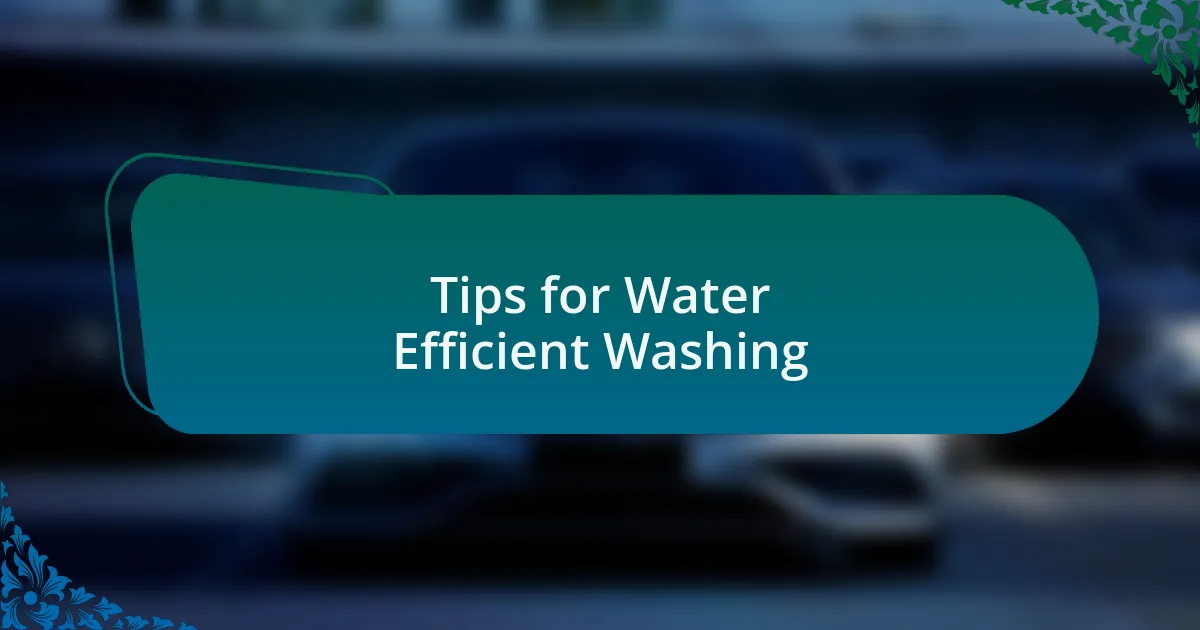
Tips for Water Efficient Washing
When washing my car, I always make it a point to fill a bucket with soapy water instead of letting the hose run continuously. I remember the first time I did this; it felt almost revolutionary! By rinsing only when necessary, I not only conserved water but also realized how easily I could control the amount I used. Have you ever tried this method? It’s surprisingly liberating.
I also discovered the joy of washing my car in the early morning or late evening, when temperatures are cooler and I can work without the sun evaporating my precious water. I recall one scorching afternoon, where my soap was drying on the paint before I could rinse it off. Since then, I never underestimate the timing of my wash. It makes a difference, and I get to enjoy a little quieter time with my car.
Using microfiber towels instead of traditional ones when drying has been another fantastic tip for reducing waste. Not only do they absorb more water, but they also leave a streak-free finish. I was blown away by how effective these towels are. They felt like a small upgrade in my car washing routine. Have you made any changes lately that have transformed your experience? Each improvement, no matter how small, helps us become more efficient water users.
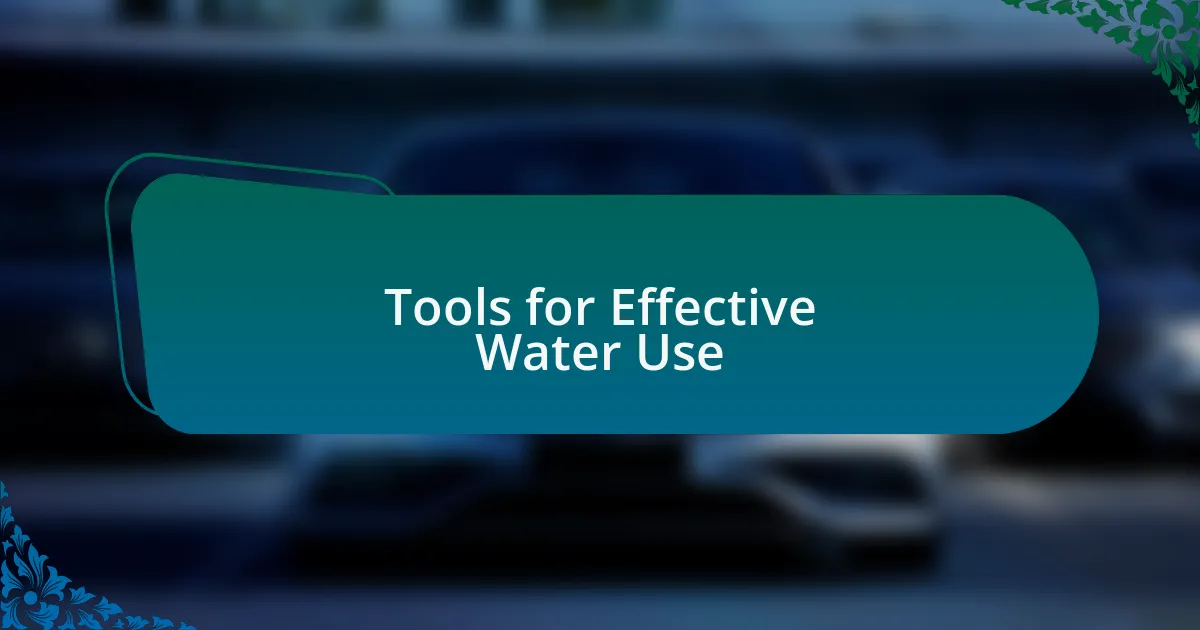
Tools for Effective Water Use
When it comes to tools for effective water use, I highly recommend investing in a high-pressure washer. I remember the first time I used one; it amazed me how much dirt I could blast away with minimal water. This tool not only saves water but also makes the entire washing process faster and more satisfying. Have you ever tried one? You might be surprised by the results!
Additionally, a well-designed foam cannon can be a game changer. Picture this: instead of drenching the car with water first, you apply a thick layer of foam that clings to the surface. I’ve found that it loosens grime with far less water than traditional methods allow. Not only does it make for an effective pre-wash, but it also turns washing into a fun, almost artistic task, as I watch the foam do its magic.
Another simple yet effective tool is a water-saving nozzle. I was skeptical at first, thinking it wouldn’t make much of a difference. But after trying it, I was impressed by how it controlled the flow while still offering a strong spray. This made rinsing much more efficient. Have you noticed how small adjustments can lead to substantial changes? Each tool in our washing arsenal can contribute significantly to conserving water and improving our practices.

Personal Strategies for Reducing Waste
When it comes to reducing water waste, one of my favorite strategies is to wash my car only when absolutely necessary. I used to wash my car weekly, regardless of its condition, but I’ve realized that a quick visual check can save a lot of water. Is it really dirty, or just dusty? By being more mindful, I’ve cut down my washing frequency and feel more in tune with my vehicle’s needs.
I’ve also started using buckets instead of a constant flow of water. The first time I tried the two-bucket wash method—one for soapy water and the other for rinsing—I was taken aback by how effective it was. I found that not only did it minimize my water use, but it also allowed me to focus on each section of the car, resulting in a more thorough clean. Have you ever noticed how a little bit of effort can yield a big difference?
I’ve learned to embrace quick spot cleans instead of full washes. Whenever I notice a bird dropping or some mud splatter, I grab a spray bottle filled with water and a microfiber cloth. It feels great to tackle small messes without wasting a whole bucket of water for a wash. Plus, it helps me keep my car looking sharp with minimal effort. Don’t you think small, consistent actions can add up to significant changes?
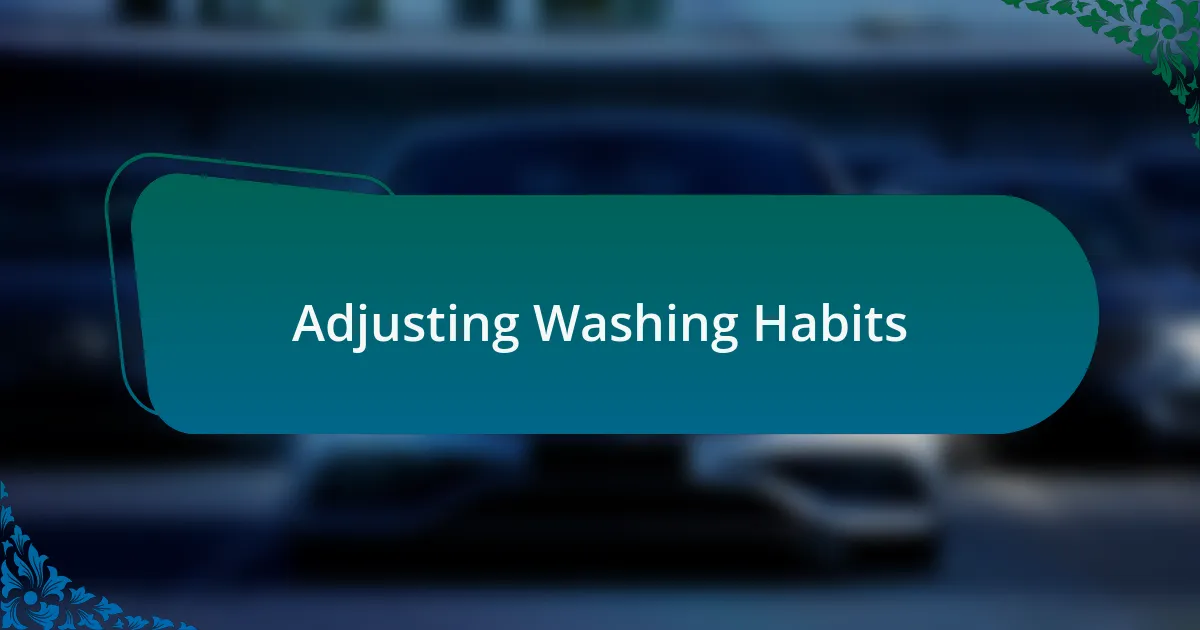
Adjusting Washing Habits
When I decided to adjust my car washing habits, one key change was to pay attention to the weather. Have you ever washed your car right before a rainstorm? I did once, and it felt like such a waste. Now, I check the forecast before planning a wash, ensuring I only clean my car when the weather is clear, which not only saves water but also keeps my efforts from being undone by the elements.
I’ve also taken a closer look at the products I use. Swapping out traditional hose sprays for waterless car wash solutions has been a game changer. The first time I used a waterless product, I was pleasantly surprised by how effective it was. It felt satisfying to know I was saving gallons of water while getting that shiny finish that makes my car feel brand new. When was the last time you considered the impact of your cleaning products?
Lastly, I’ve become more strategic about my location when washing. I often choose to wash my car at a commercial car wash that recycles water. Initially, I was skeptical about whether the quality would be up to par, but after trying it out, I felt relieved to know that my washing was contributing to a more sustainable practice. Have you thought about where you wash your car, and how that choice could affect your water use?
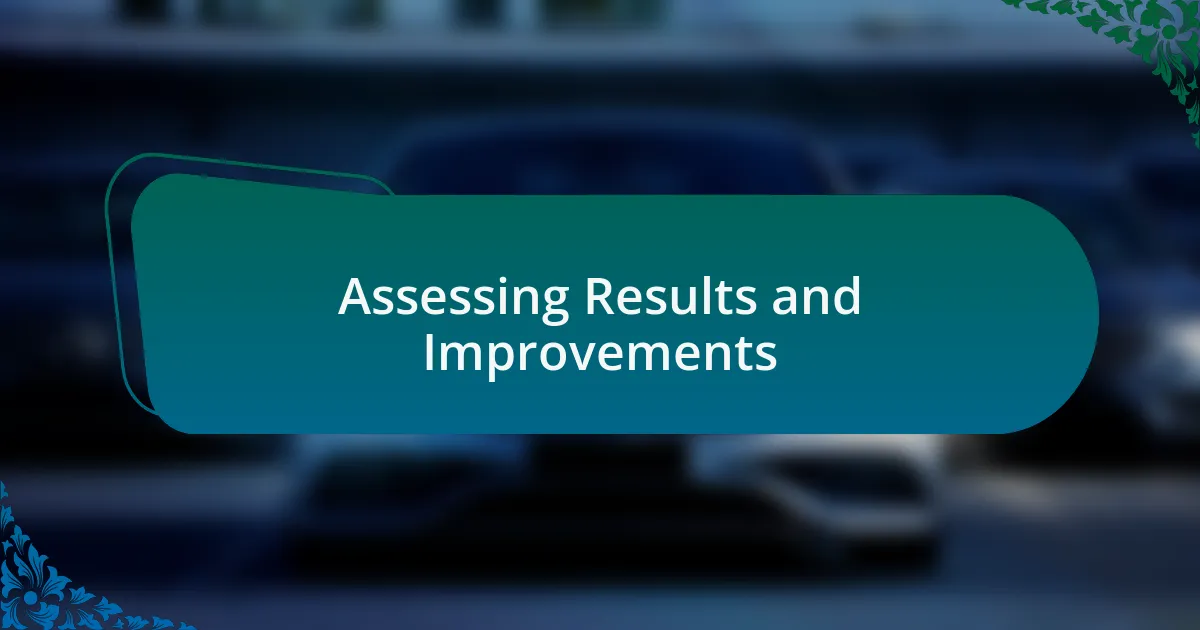
Assessing Results and Improvements
As I began implementing these water-saving habits, I started keeping track of my water usage each time I washed my car. It was eye-opening to see the difference when I recorded how much I was using before and after making these adjustments. I remember feeling a rush of accomplishment when I realized I was saving nearly fifty gallons of water per wash—who knew a few simple changes could yield such significant results?
Over time, I also noticed improvements in my car’s appearance. It felt gratifying to see my vehicle not just clean but gleaming, thanks to my more mindful washing practices. Have you ever noticed how a clean car boosts your mood? I can say from personal experience that the combination of using eco-friendly products and efficient washing methods truly transformed how I felt about maintaining my vehicle.
Now, I regularly reassess my techniques to see where I can do better. Each wash presents a new opportunity to refine my methods and discover even more ways to save water. Reflecting on my journey makes me wonder—what innovative practices might I still be missing? I encourage you to consider your own habits; small tweaks can lead to substantial improvements in both results and water savings.